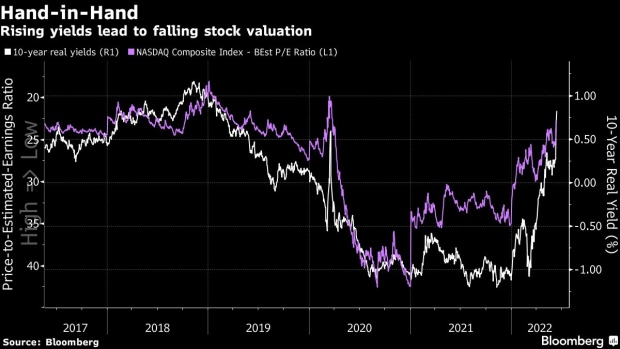Jun 14, 2022
Real-Yield Rout Bigger Than 2008 Inflicts Pain Across the World
, Bloomberg News

(Bloomberg) -- By one measure, the damage to speculative risk assets inflicted by the bond market has never been this fast and furious.
Yields on Treasury inflation-protected securities over the next decade -- seen as the true benchmark for borrowing costs in the real world -- have soared 158 basis points over the past 60 trading days while the Federal Reserve turned ever-more hawkish.
It’s the biggest surge since the US government started selling the securities in the late 1990s, surpassing routs during the global financial crisis and the Taper Tantrum of 2013.
Ten-year real rates have jumped to 0.83%, compared with a record low of minus 1.25% just seven months ago. The yields have ascended since the Fed kicked off the monetary-tightening campaign in March and have accelerated since last week when a surprisingly hot inflation report fueled expectations of more forceful rate hikes.
In turn, the real-rate rout has single-handedly pushed the nominal 10-year Treasury yields to the highest since 2011.
Investors are now predicting that nominal Treasuries will yield more than the cost of living for the next decade by the biggest margin since 2019. That’s a world away from the pandemic era of financial repression for investors in the world’s biggest bond market.
Rate Pain
All this is spurring big moves in risky corners of financial markets.
Over the past two years, negative real borrowing costs allowed everything from cryptocurrencies to profitless tech stocks to shoot to the moon, minting countless young millionaires who claimed old-school investors such as Warren Buffett were relics of the past.
Now these rate-sensitive trades are reeling. The received wisdom is that when inflation-adjusted yields rise, assets bereft of immediate income streams will naturally fall given the rising opportunity costs for investors who hold them.
At same time, rising yields hammer stock valuations by reducing the present value of corporates earnings ahead, especially those companies that can only generate cash flow years in the future. The price-to-estimated earnings of the Nasdaq Composite Index fell to about 21 this week, from 31 at the start of the year.
That’s not all. Higher US real rates are draining foreign capital away for leveraged emerging-market borrowers, sending currencies from the Turkish lira to Indian rupee to historic lows.
“Almost every EM currency weakens vs. USD as US yields rise,” wrote Mitul Kotecha, emerging-market strategist at TD Securities in a note. “Much going forward will depend on the message the Fed delivers this week, but it’s hard to call a top in nominal US or real yields at present.”
©2022 Bloomberg L.P.





